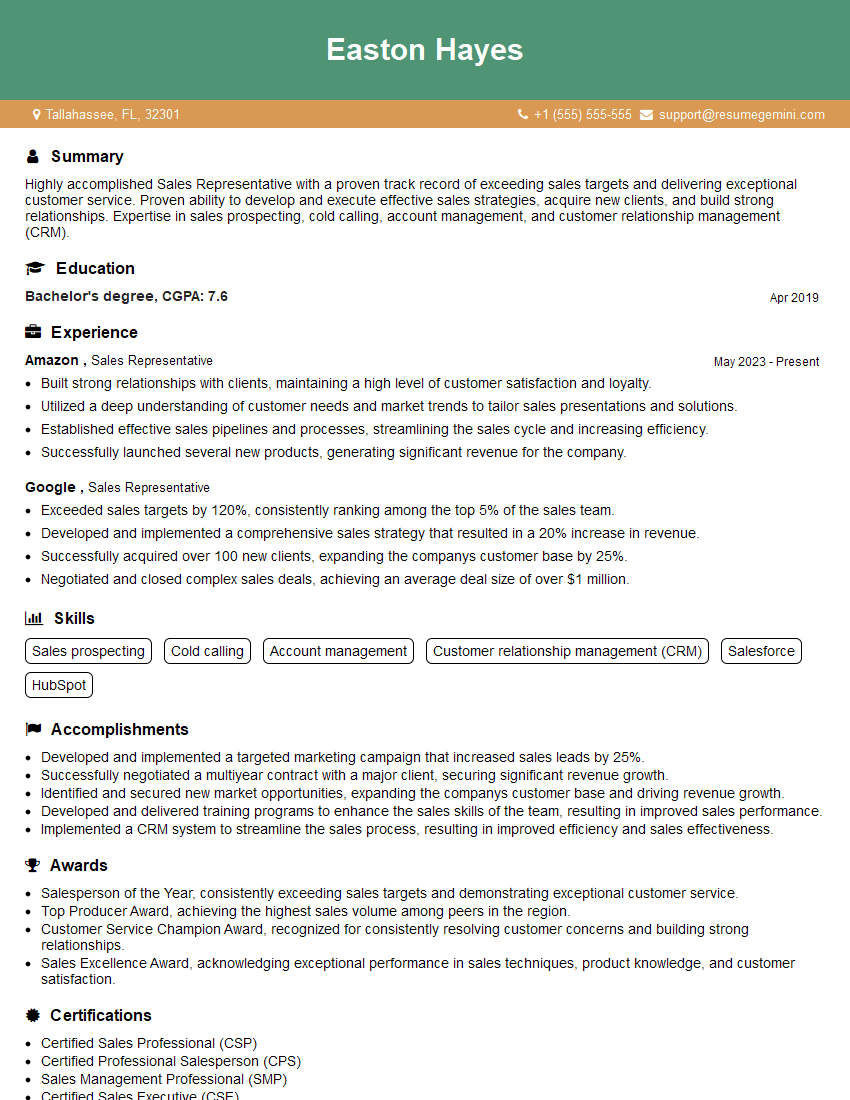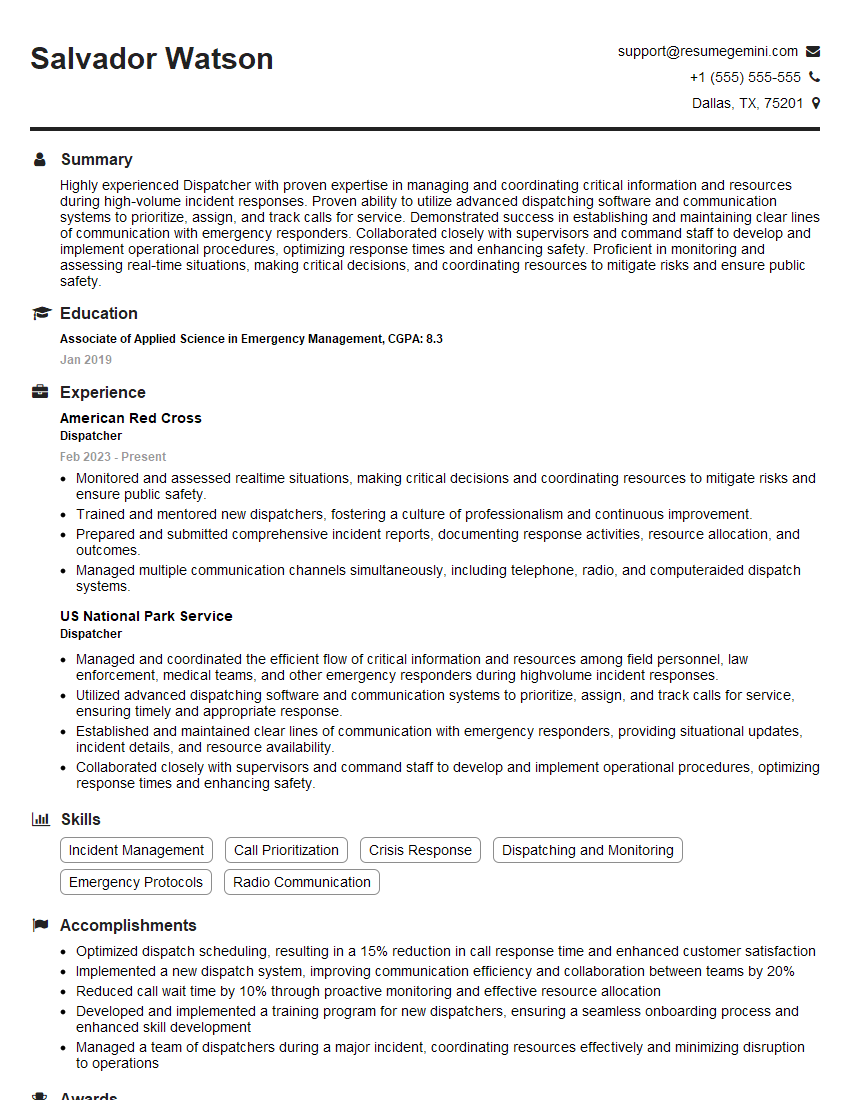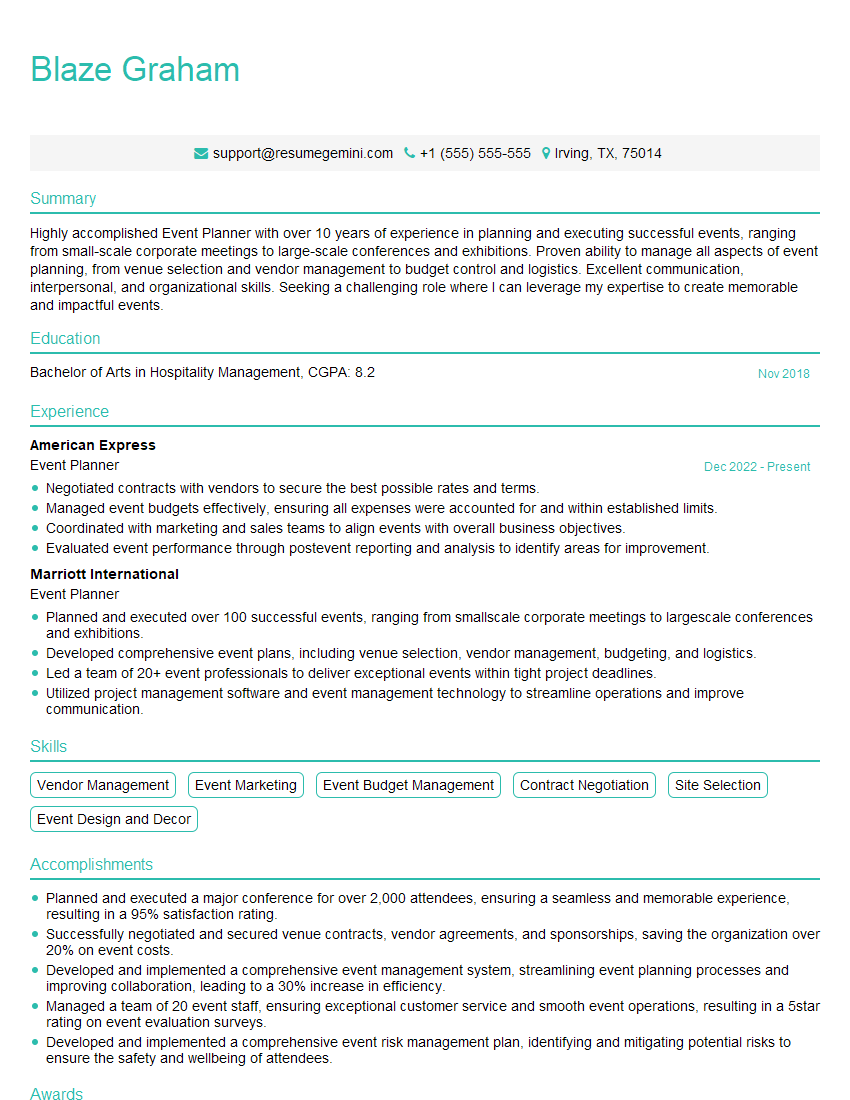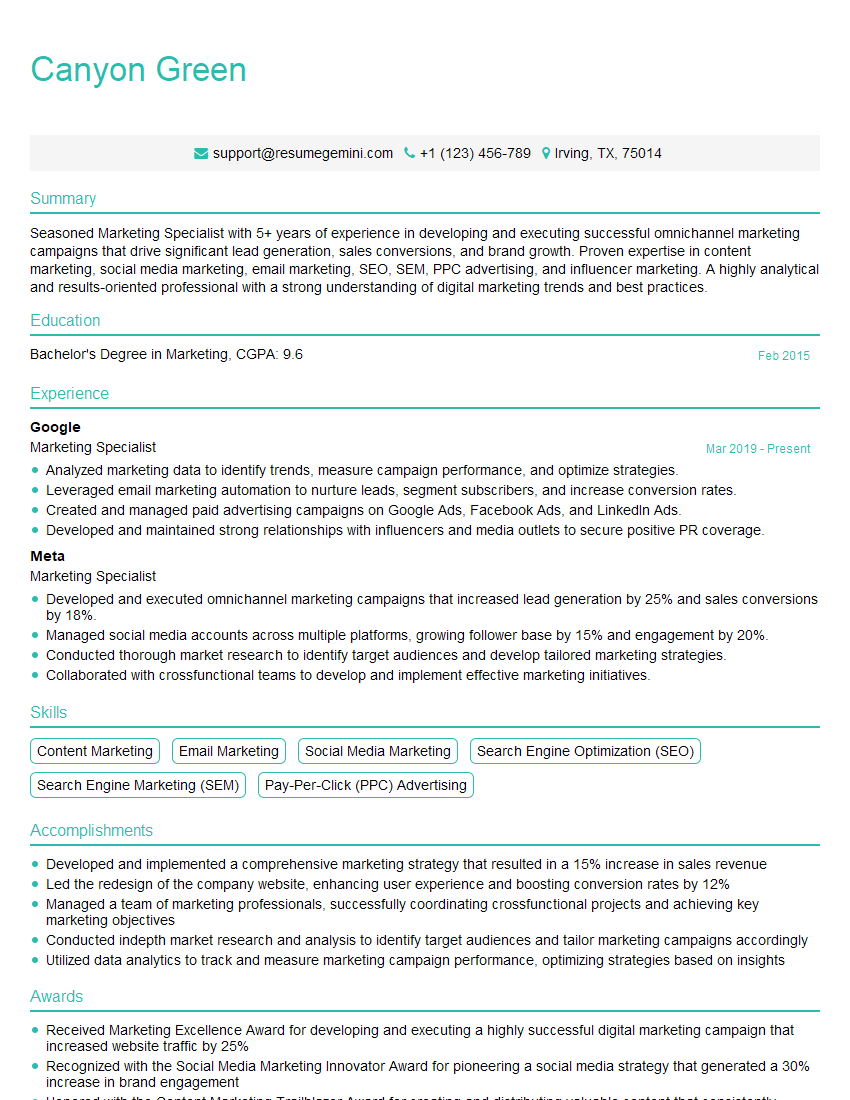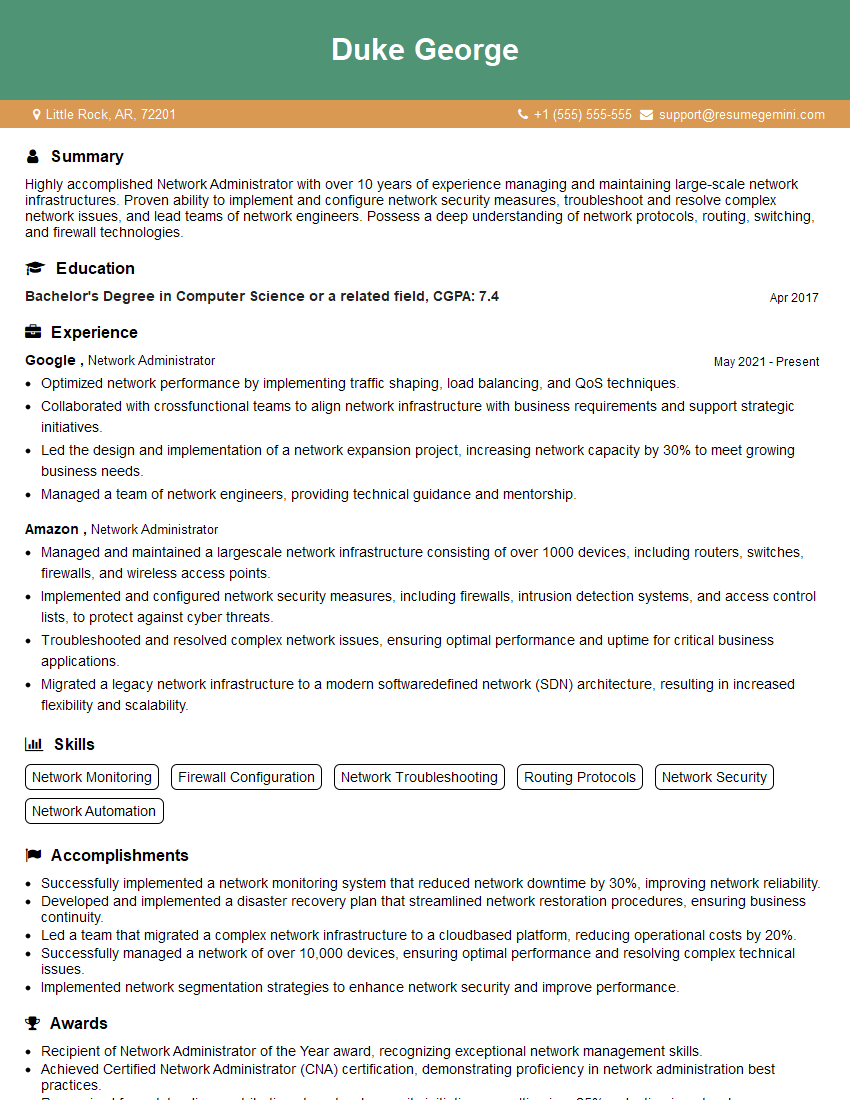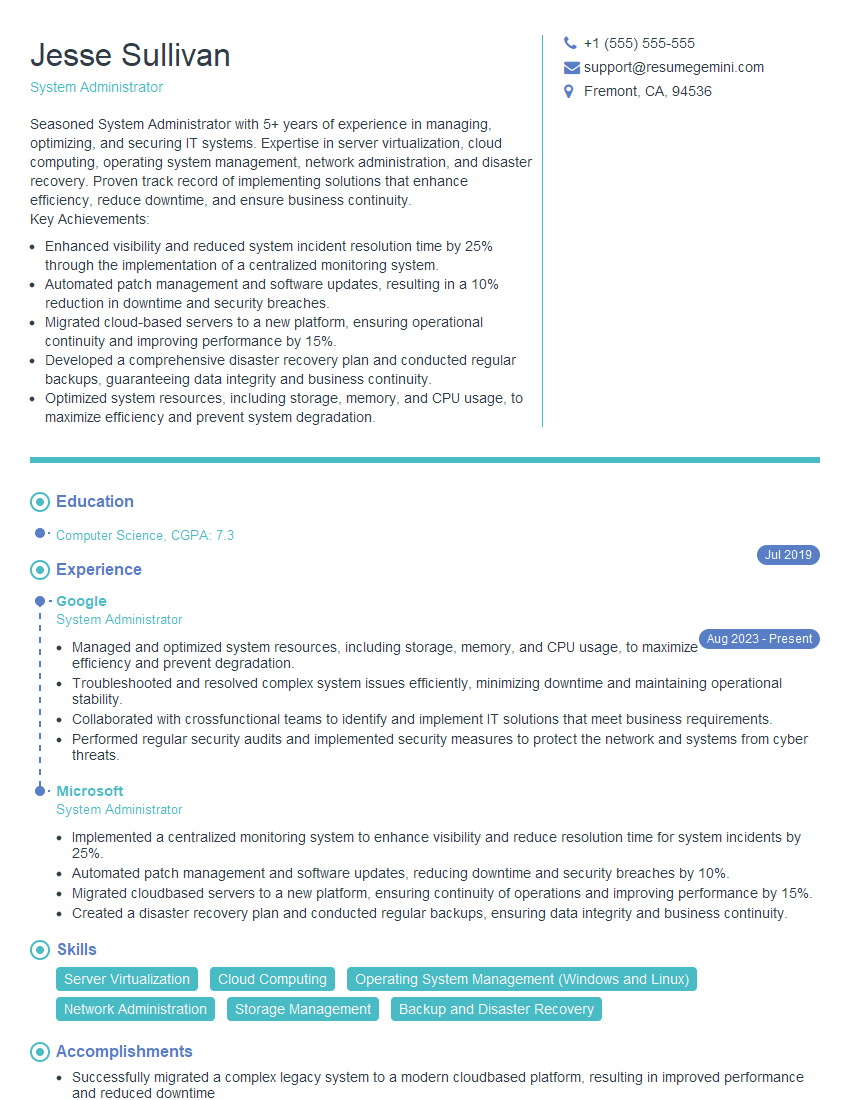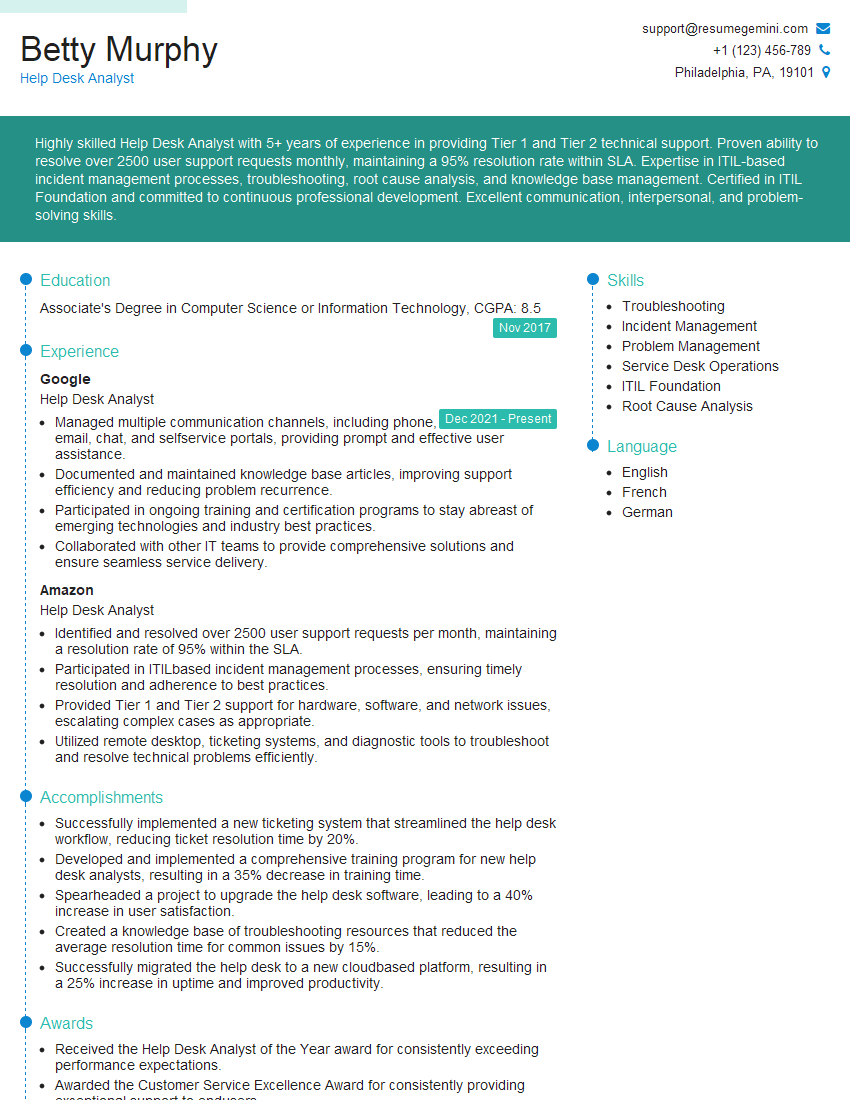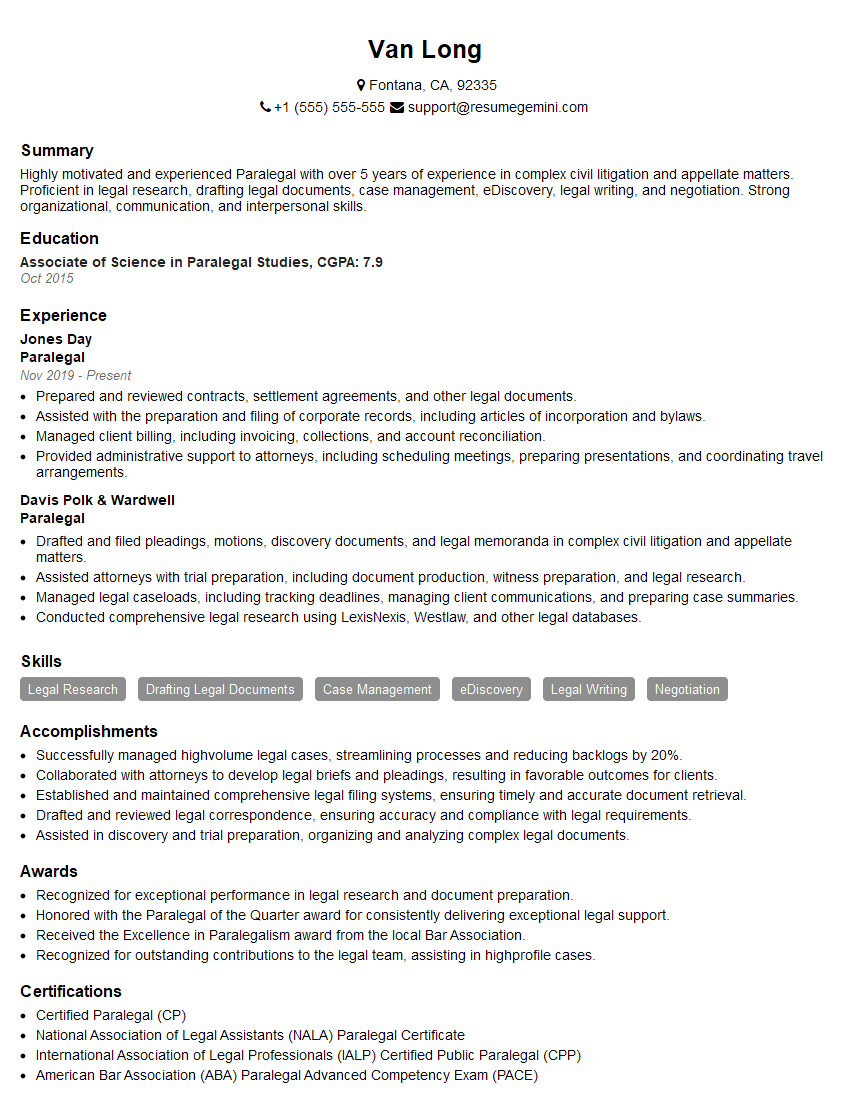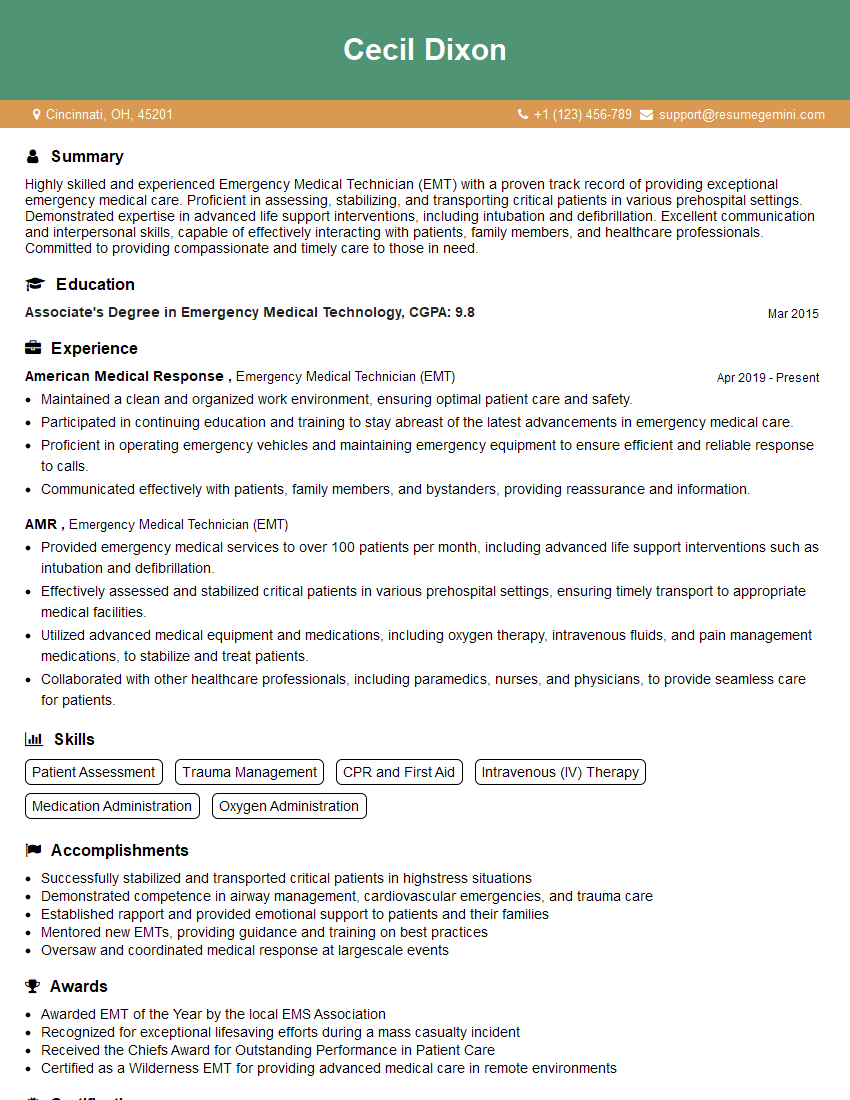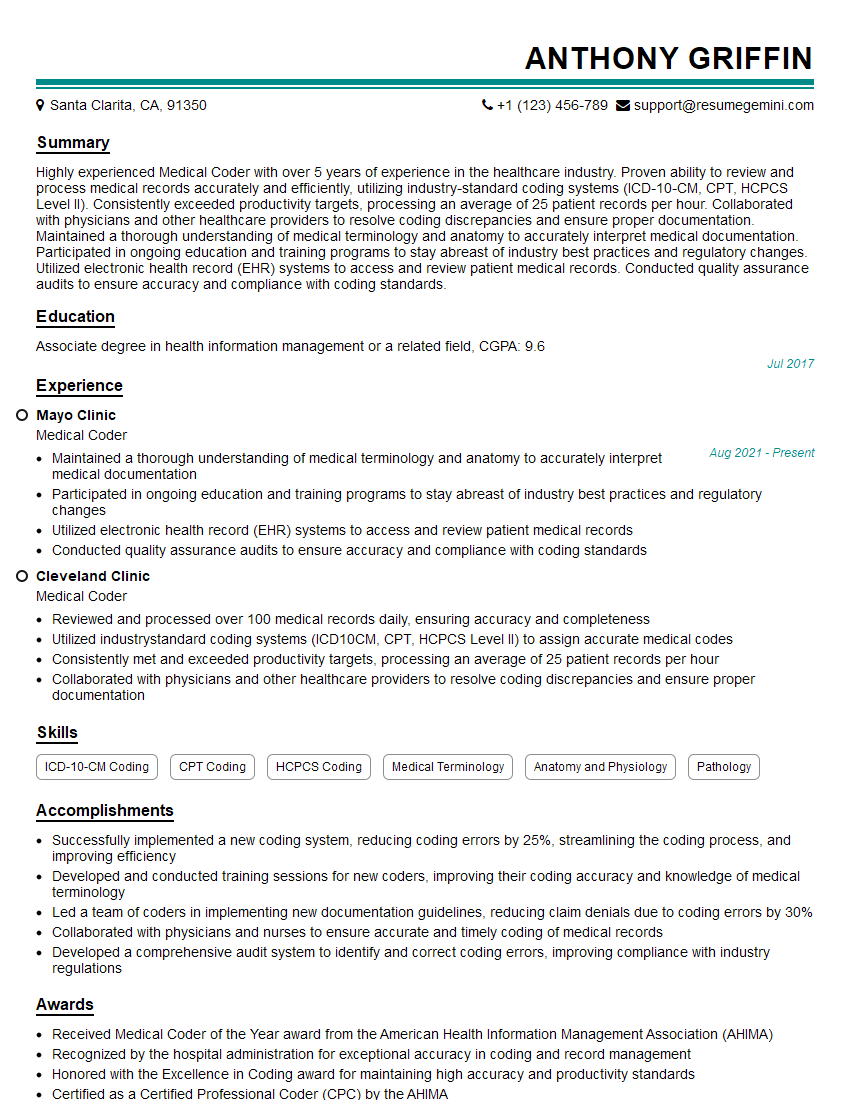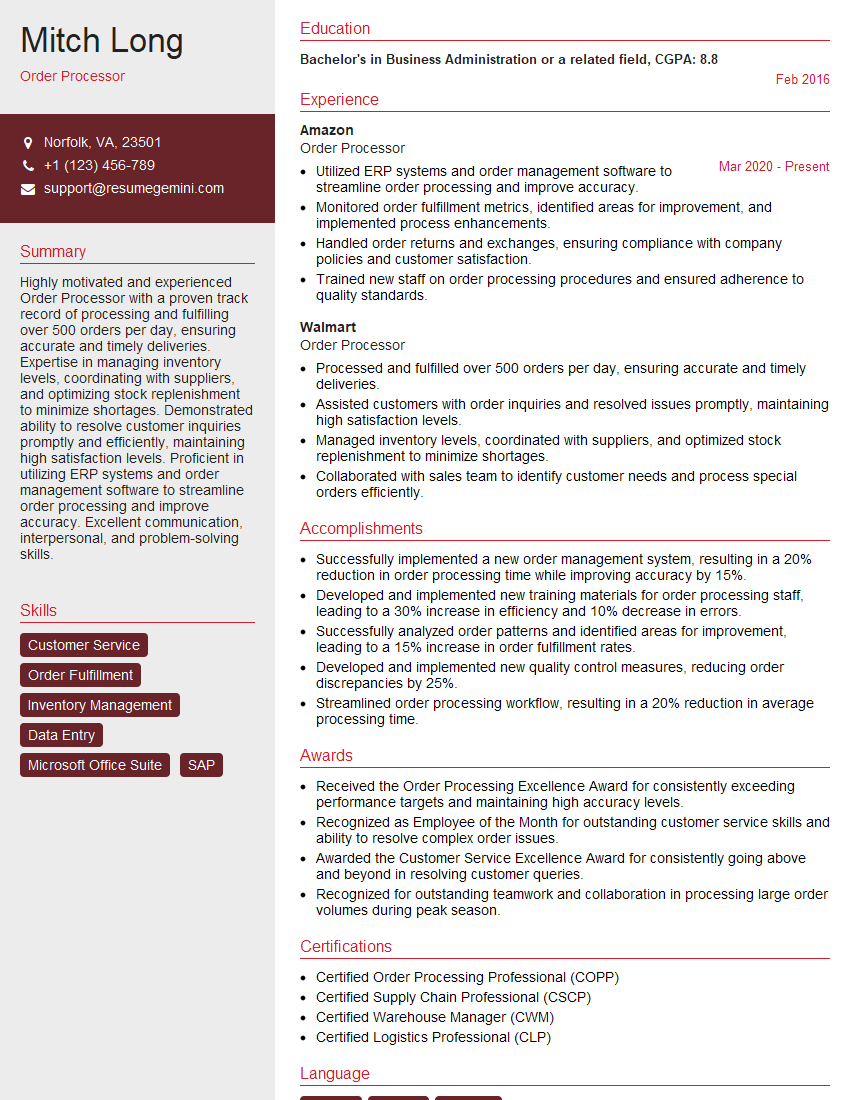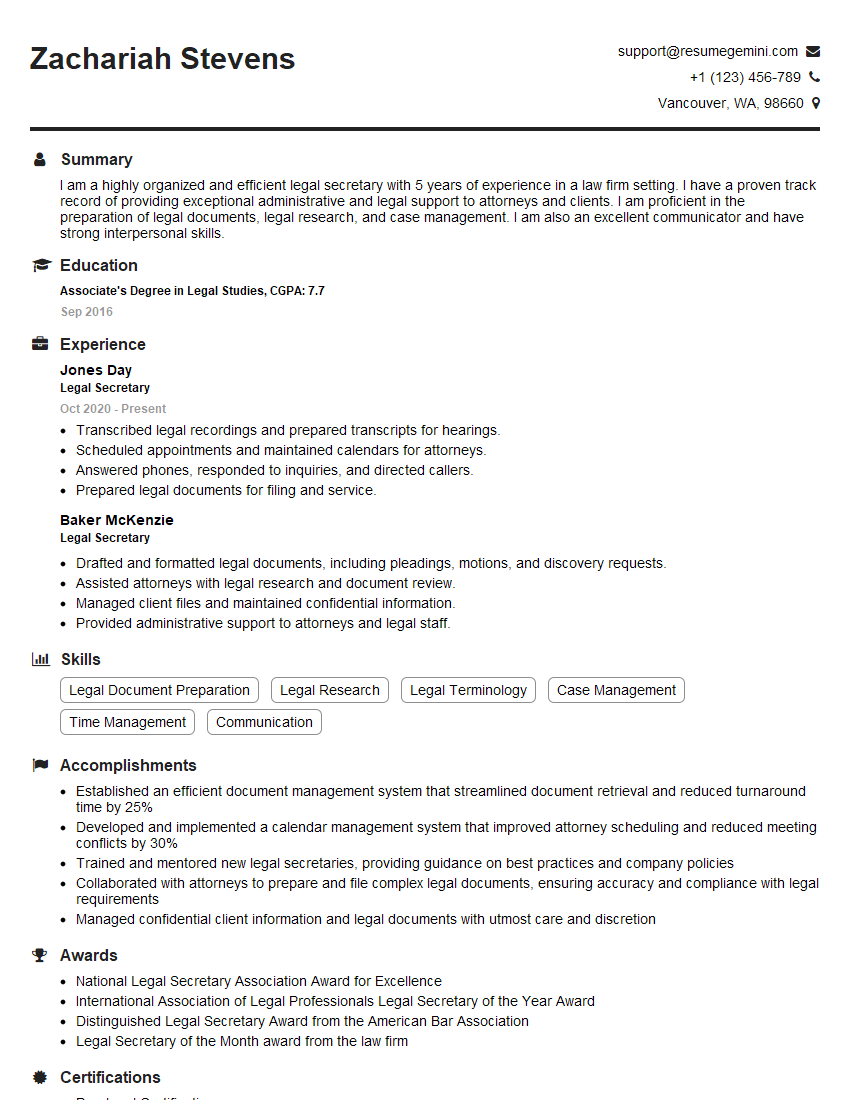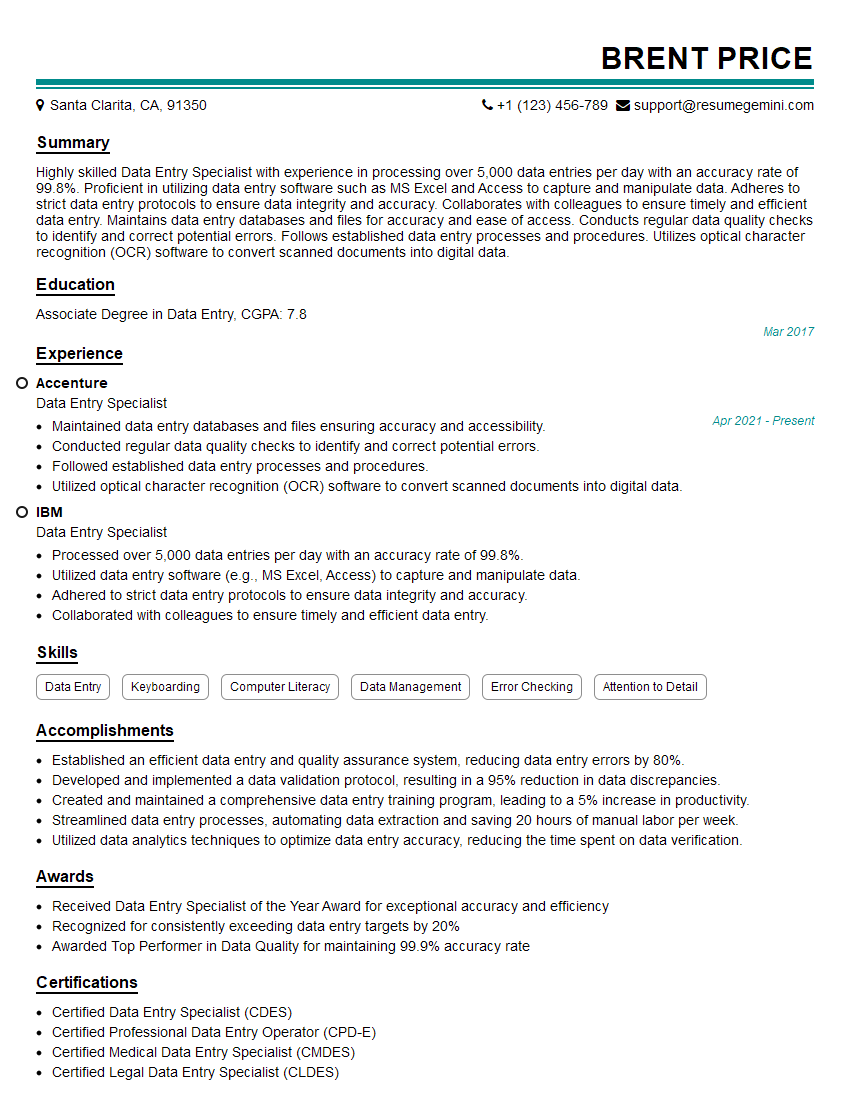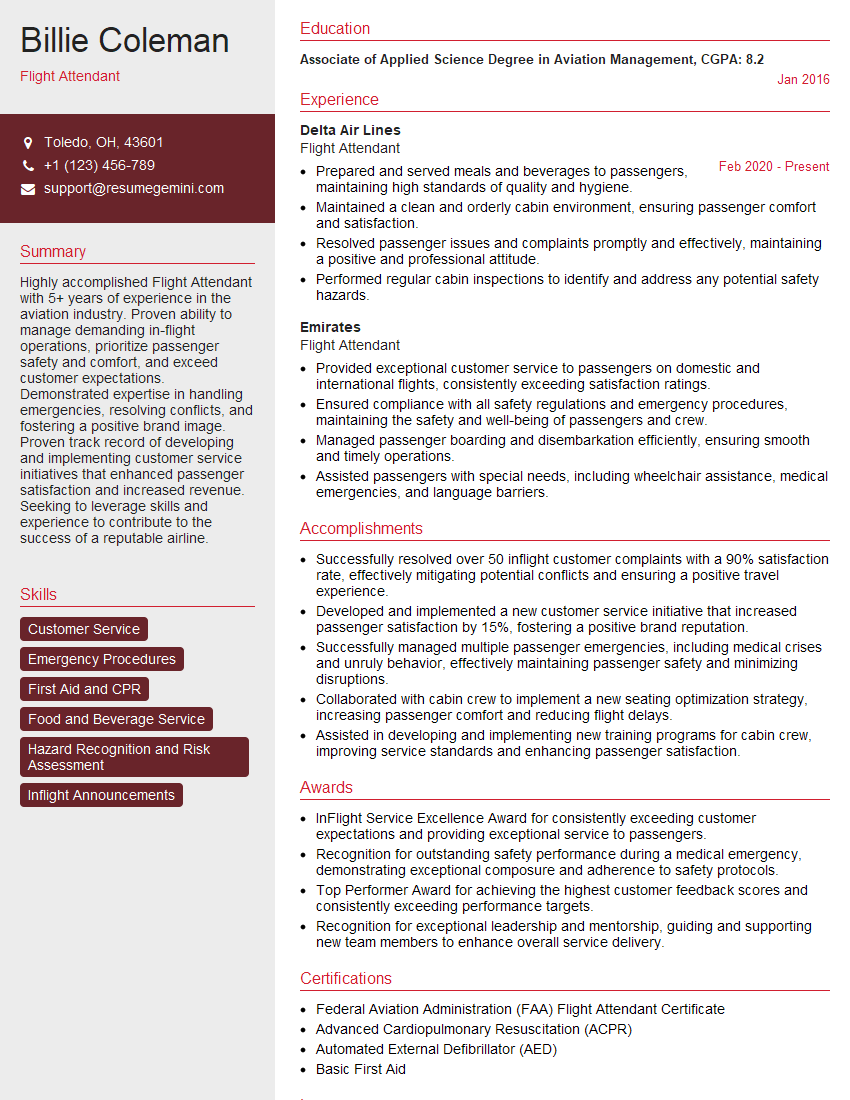Every successful interview starts with knowing what to expect. In this blog, we’ll take you through the top Ability to Work in a High-Volume, Time-Sensitive Environment interview questions, breaking them down with expert tips to help you deliver impactful answers. Step into your next interview fully prepared and ready to succeed.
Questions Asked in Ability to Work in a High-Volume, Time-Sensitive Environment Interview
Q 1. Describe your experience managing multiple tasks with competing deadlines.
Managing multiple tasks with competing deadlines requires a structured approach. It’s like conducting an orchestra – each instrument (task) has its own part, its own tempo, and its own deadline. My experience involves consistently using prioritization techniques and time management strategies to ensure all tasks are completed successfully, even under significant pressure.
In my previous role at Acme Corp, I routinely handled 5-7 projects simultaneously, each with varying levels of urgency and complexity. I used project management software to track progress, deadlines, and dependencies between tasks. This allowed me to visualize the workload and allocate my time effectively. For example, if one project required a quick turnaround on a specific component, I would prioritize that component while dedicating designated time blocks for other ongoing projects. This proactive approach ensured no project fell behind schedule.
Further, regular communication with stakeholders was crucial. Keeping them informed of potential roadblocks or delays allowed for proactive adjustments and prevented unexpected crises. Open communication minimized misunderstandings and ensured that everyone was on the same page, contributing to a smoother workflow.
Q 2. How do you prioritize tasks in a high-pressure situation?
Prioritizing tasks in high-pressure situations involves a blend of strategic thinking and decisive action. I employ the Eisenhower Matrix (Urgent/Important), which helps categorize tasks based on their urgency and importance. This allows me to focus on high-impact, time-sensitive tasks while strategically scheduling less urgent but important tasks.
Imagine a fire – you wouldn’t spend time watering the lawn while your house is on fire. Similarly, in a crisis, I identify the ‘house fire’ tasks – the most critical ones that could have the most significant negative impact if delayed – and address those first. Then, I tackle important but not urgent tasks, ensuring they don’t become urgent later. Less important tasks are either delegated or postponed.
This approach minimizes wasted effort and maximizes efficiency by focusing on the most impactful activities first. I constantly re-evaluate priorities as new information emerges, making adjustments as needed to maintain optimal workflow.
Q 3. What strategies do you use to stay organized in a fast-paced environment?
Staying organized in a fast-paced environment is paramount to success. I rely on a multi-pronged approach incorporating technology and effective strategies. This keeps me from feeling overwhelmed by the sheer volume of work.
- Project Management Software: Tools like Asana, Trello, or Monday.com provide a centralized location to track projects, deadlines, and task assignments. They allow for collaboration and provide a clear overview of my workload.
- Detailed To-Do Lists: I break down large tasks into smaller, manageable steps. This prevents feeling overwhelmed and provides a sense of accomplishment as I complete each step.
- Time Blocking: Allocating specific time blocks for specific tasks minimizes multitasking and improves focus. This prevents context-switching, which significantly reduces productivity.
- Regular Clean-up: I dedicate time each day or week to declutter my workspace, both physical and digital. A clean workspace equates to a clear mind.
This organized approach allows for efficient task management and prevents crucial details from being overlooked in the chaos of a fast-paced setting.
Q 4. How do you handle interruptions and distractions while working on urgent tasks?
Interruptions and distractions are inevitable, especially in a fast-paced environment. However, they can be mitigated with proactive strategies.
- Communicate Boundaries: I inform colleagues of my focus time and availability. This minimizes unnecessary interruptions during critical periods.
- Dedicated Workspace: I create a dedicated workspace, free from distractions as much as possible, to foster concentration. This might involve using noise-canceling headphones or finding a quiet area.
- Batching Similar Tasks: Grouping similar tasks together (e.g., answering emails all at once) reduces context switching and enhances focus.
- Utilizing Technology: Tools like website blockers or focus apps help minimize distractions from social media or other non-work-related websites.
By proactively managing interruptions, I maximize focused work time and minimize the negative impact of distractions on productivity.
Q 5. Give an example of a time you had to meet an impossible deadline.
During a major system upgrade at my previous company, we faced an impossible deadline. The upgrade needed to be completed within 24 hours, a timeframe far shorter than originally estimated. The pressure was immense.
Our team immediately implemented a crisis management plan. We divided the work into smaller, manageable tasks and assigned them based on individual expertise. We worked in shifts, around the clock, to maximize progress. We also prioritized essential functionalities over less critical ones, ensuring a core functional system was launched even if some features were delayed.
While we didn’t achieve 100% completion within 24 hours, we successfully launched a stable, functional system within 30 hours. The immediate success prevented major business disruption, highlighting the importance of decisive action, clear communication, and teamwork under immense pressure. This experience taught me the importance of adaptability and problem-solving when faced with seemingly insurmountable challenges.
Q 6. How do you handle conflicting priorities?
Handling conflicting priorities requires careful analysis, effective communication, and sometimes, difficult choices. When facing this challenge, I follow a structured approach:
- Clarify Priorities: I clearly define and understand the goals and objectives behind each competing priority. This helps identify which tasks are most strategically important.
- Assess Impact: I analyze the potential consequences of delaying or compromising on each priority. This helps make informed decisions about resource allocation.
- Communicate and Negotiate: Open communication with stakeholders is crucial. This may involve explaining the constraints and negotiating adjusted expectations or timelines.
- Make Difficult Decisions: Sometimes, compromises must be made. I strive to make decisions that minimize negative impacts while achieving the most important goals.
This approach minimizes conflicts and ensures resources are allocated effectively to achieve the most significant outcomes.
Q 7. Describe your experience working under pressure.
Working under pressure is an integral part of my professional life, and I thrive in such environments. I’ve consistently demonstrated the ability to perform effectively under tight deadlines and high-stakes situations. My experience has equipped me with the skills and strategies to manage pressure constructively, rather than letting it overwhelm me.
I find that a calm and methodical approach is key. I focus on breaking down complex tasks into manageable steps, maintaining clear communication with my team, and prioritizing tasks effectively. I also prioritize self-care, ensuring I get adequate rest and maintain a healthy work-life balance to avoid burnout. This allows me to maintain focus and productivity even when facing demanding situations.
The ability to remain calm and focused under pressure isn’t innate; it’s a skill honed through experience and deliberate practice. I’ve consistently sought opportunities to challenge myself and further develop this crucial skill.
Q 8. How do you delegate tasks effectively in a high-volume environment?
Effective delegation in a high-volume environment is about more than just assigning tasks; it’s about optimizing team resources and ensuring everyone’s strengths are utilized. I begin by clearly defining the task, outlining specific expectations, and setting realistic deadlines. This includes providing all necessary resources and context. Then, I assess my team’s skills and workloads. I match tasks to individual capabilities, considering their experience and current capacity. For example, if a new team member is learning a specific software, I’ll assign them tasks that allow them to practice while still contributing to the overall output. Finally, I establish clear communication channels for updates and troubleshooting. Regular check-ins help ensure tasks are on track and allows for early identification of potential bottlenecks.
For instance, in my previous role, we faced a sudden surge in client requests. Instead of overwhelming myself, I delegated tasks based on individual expertise. One team member, adept at data analysis, handled the initial data processing. Another, strong in communication, managed client correspondence. This division of labor ensured both speed and accuracy, exceeding expectations despite the pressure.
Q 9. How do you maintain accuracy while working quickly?
Maintaining accuracy while working quickly requires a blend of efficient workflows and diligent practices. First, I prioritize organization. This means employing strategies like creating detailed checklists, using templates for repetitive tasks, and meticulously documenting every step. Second, I incorporate quality control checkpoints throughout the process. This could involve self-checking my work at regular intervals or implementing peer reviews. Lastly, I leverage technology to my advantage. Automation tools can significantly reduce errors in repetitive tasks, freeing up my time for more complex work. I always prioritize accuracy over speed; a small error can undo a lot of rapid work.
For example, in a previous project involving data entry, I utilized a spreadsheet formula to automatically cross-reference data, minimizing the chance of manual input errors. This, coupled with regular spot checks, ensured both the speed and the accuracy of the data entry.
Q 10. What methods do you use to manage stress in a demanding work environment?
Managing stress in a demanding environment is crucial for both productivity and well-being. My approach is multifaceted. Firstly, I prioritize time management. Breaking down large tasks into smaller, manageable chunks makes them less daunting. I also utilize time-blocking techniques, allocating specific time slots for different tasks. Secondly, I maintain a healthy work-life balance. Regular breaks, physical activity, and sufficient sleep are essential for preventing burnout. Thirdly, mindfulness techniques, like deep breathing exercises or short meditation sessions, help me stay calm and focused under pressure. Finally, open communication with my supervisor about workload helps us proactively address potential stressors.
I find that even short breaks every hour make a big difference. A quick walk, a few stretches, or even just a minute of quiet reflection can significantly improve focus and reduce stress levels.
Q 11. How do you adapt to changing priorities?
Adapting to changing priorities requires flexibility and a proactive approach. I begin by understanding the reason for the change and its impact on existing tasks. Then, I prioritize tasks based on urgency and importance, using a framework like the Eisenhower Matrix (urgent/important). This allows me to re-allocate resources and adjust deadlines accordingly. Open communication with team members and supervisors is also crucial to ensure everyone is on the same page. I often use visual aids, like Kanban boards or project management software, to track progress and highlight any adjustments required.
For instance, if a high-priority project suddenly requires my attention, I might need to postpone less critical tasks or seek assistance from colleagues. Transparency in communication ensures everyone understands the shift in priorities and can adjust their workload effectively.
Q 12. Describe your experience using project management software.
I have extensive experience using various project management software, including Asana, Trello, and Jira. My proficiency extends beyond basic task management. I am adept at using these platforms to create custom workflows, track progress visually using Kanban boards and Gantt charts, and manage dependencies between tasks. Furthermore, I leverage their reporting features to monitor project health and identify potential roadblocks. I find that the ability to assign tasks, set deadlines, and monitor progress in real-time is instrumental in maintaining efficiency and accountability in high-volume environments.
For example, in a recent project using Jira, I customized the workflow to reflect our specific team processes. This allowed us to track the progress of each task through different stages, from initiation to completion, ensuring nothing fell through the cracks.
Q 13. How do you ensure that all tasks are completed accurately and on time?
Ensuring all tasks are completed accurately and on time requires a meticulous approach. I begin with detailed planning, breaking down larger tasks into smaller, manageable steps with clear deadlines for each. I consistently use checklists to ensure nothing is overlooked. Regular progress reviews help identify potential delays early on. I proactively communicate any challenges or roadblocks to my team and supervisors to address them promptly. Finally, rigorous quality control measures, including self-checking and peer review, are crucial for maintaining accuracy. My focus is on proactive problem-solving rather than reactive firefighting.
For example, in one project, using a detailed Gantt chart helped me identify potential scheduling conflicts between tasks well in advance. This allowed us to adjust our timeline and resource allocation, ensuring timely completion without compromising accuracy.
Q 14. How do you manage your workload when unexpected tasks arise?
When unexpected tasks arise, I employ a prioritized approach. I assess the urgency and importance of the new task and compare it to my existing workload. If it’s urgent and crucial, I re-prioritize my existing tasks, potentially delegating or postponing some to accommodate the new one. If it’s less urgent, I schedule it into my workflow, ensuring it doesn’t disrupt ongoing projects. Open communication with my supervisor and team members is essential in this process, ensuring everyone is aware of the changes and can adapt accordingly. Flexibility and adaptability are key to managing unexpected challenges effectively.
For instance, if a critical system failure occurs, I would immediately address it, even if it means temporarily postponing other tasks. I would then communicate the situation to the team and work collaboratively to resolve the issue and minimize disruption.
Q 15. How do you communicate effectively with colleagues in a high-pressure environment?
Effective communication in high-pressure environments hinges on clarity, conciseness, and active listening. Instead of lengthy explanations, I prioritize bullet points, clear directives, and frequent check-ins. For instance, if a critical task requires immediate attention, I’d communicate via a concise email or instant message specifying the priority, deadline, and expected outcome. Follow-up communication, especially during complex projects, is crucial to maintain alignment and address potential roadblocks proactively. In a previous role, during a website launch, we used a dedicated Slack channel for immediate updates and questions, avoiding confusion and ensuring everyone was on the same page. This approach minimized misunderstandings and prevented delays caused by miscommunication.
Career Expert Tips:
- Ace those interviews! Prepare effectively by reviewing the Top 50 Most Common Interview Questions on ResumeGemini.
- Navigate your job search with confidence! Explore a wide range of Career Tips on ResumeGemini. Learn about common challenges and recommendations to overcome them.
- Craft the perfect resume! Master the Art of Resume Writing with ResumeGemini’s guide. Showcase your unique qualifications and achievements effectively.
- Don’t miss out on holiday savings! Build your dream resume with ResumeGemini’s ATS optimized templates.
Q 16. What is your preferred method for tracking progress on multiple projects?
My preferred method for tracking progress on multiple projects involves a combination of tools and techniques. I utilize project management software like Asana or Jira, creating detailed tasks with assigned deadlines and responsibilities. This allows for easy visualization of the workflow and immediate identification of potential delays. Furthermore, I maintain a personal Kanban board (either physical or digital) to visually manage my workload, ensuring a holistic overview of all projects. Regular status meetings, accompanied by concise progress reports, provide a platform for open communication and ensure everyone remains aligned. Using a color-coded system on my Kanban board—green for completed tasks, yellow for in-progress, and red for blocked tasks—helps me instantly prioritize tasks and identify areas needing attention.
Q 17. How do you handle setbacks or unexpected delays?
Setbacks are inevitable in high-volume environments. My approach involves a structured problem-solving process. First, I acknowledge the setback and assess its impact. Then, I identify the root cause—was it a technical issue, a resource constraint, or a miscommunication? Once the root cause is understood, I brainstorm solutions with my team, prioritizing options based on feasibility and impact. Finally, I implement the chosen solution, documenting the changes made and monitoring progress to prevent similar occurrences in the future. During a particularly challenging product launch, a critical software bug caused significant delays. Instead of panic, we immediately initiated a bug-fixing sprint, transparently communicating progress to stakeholders and adjusting the launch timeline accordingly. This proactive approach minimized negative impact and demonstrated adaptability.
Q 18. Describe a time you had to make a quick decision under pressure.
In a previous role, we were facing a critical server outage during a peak sales period. The website was down, and customer orders were piling up. Under immense pressure, I had to quickly decide whether to attempt a temporary fix, risking further damage, or to initiate a full system rollback, causing a longer downtime but ensuring data integrity. After swiftly assessing the risks and consulting with the senior engineer, I opted for the system rollback. This decision, although initially resulting in a longer downtime, ultimately prevented significant data loss and maintained customer trust. While stressful, the situation taught me the importance of decisive action combined with careful risk assessment.
Q 19. What’s your process for identifying and addressing potential bottlenecks?
Identifying bottlenecks requires careful observation and proactive analysis. I regularly review project timelines, identifying tasks exceeding their allocated time or experiencing dependencies on other tasks. Tools like Gantt charts visually highlight potential bottlenecks. Direct communication with team members involved in affected tasks is vital to understand underlying challenges. Once a bottleneck is identified, I work with the team to find solutions, such as reassigning tasks, allocating additional resources, or streamlining processes. For instance, in a previous project, a prolonged design review was delaying development. By streamlining the review process and assigning a dedicated reviewer, we successfully eliminated the bottleneck, keeping the project on schedule.
Q 20. How do you identify and utilize your team’s strengths in a high-volume setting?
Leveraging team strengths in a high-volume setting is crucial for efficiency. I begin by identifying each team member’s skills and experience through open communication and observation. I then strategically allocate tasks based on these strengths, ensuring individuals are working in their areas of expertise. Regular feedback sessions and collaborative brainstorming foster a sense of ownership and encourage team members to contribute their unique talents. For example, during a large-scale project, I assigned the data analysis to our team member with strong analytical skills, and the presentation design to our creative team member. This division of labor, based on individual strengths, resulted in higher quality output and increased efficiency.
Q 21. How do you use technology to improve efficiency in a fast-paced environment?
Technology is integral to efficiency in fast-paced environments. I utilize project management software for task assignment, progress tracking, and communication. Automation tools, such as Zapier or IFTTT, can streamline repetitive tasks, freeing up time for more complex activities. Data analytics dashboards provide real-time insights into project progress, allowing for proactive adjustments. Furthermore, collaborative platforms like Google Docs or Microsoft Teams facilitate seamless teamwork, regardless of location. In a past project, using a project management tool with automated reporting significantly reduced the time spent on manual status updates, allowing us to focus on core tasks and accelerate project completion.
Q 22. How do you balance speed and accuracy in your work?
Balancing speed and accuracy is crucial in high-volume environments. It’s not about choosing one over the other, but rather optimizing a workflow that leverages both. Think of it like a skilled surgeon – precise movements are essential, yet speed is critical in minimizing patient risk. My approach involves several key steps:
- Prioritization and Planning: I begin by prioritizing tasks based on urgency and impact, creating a realistic schedule that accounts for potential delays. Using tools like Kanban boards can help visualize workflow and identify bottlenecks.
- Process Optimization: I constantly look for ways to streamline my processes. This might involve automating repetitive tasks using macros or scripts, or finding more efficient software solutions. For example, in a previous role, I automated data entry using Python, reducing processing time by 60%.
- Quality Checks: Building in quality checks throughout the process – not just at the end – is paramount. Regular spot checks and utilizing validation tools ensure early detection and correction of errors, preventing costly rework. I often employ ‘four-eyes’ principle where another colleague reviews critical tasks before submission.
- Practice and Proficiency: Consistent practice hones both speed and accuracy. The more familiar I am with the task, the more efficiently and accurately I can perform it. Continuous learning and upskilling are crucial in maintaining high standards in a rapidly evolving environment.
Q 23. Describe your experience working with large datasets or high volumes of information.
I have extensive experience working with large datasets and high volumes of information. In my previous role at [Previous Company Name], I routinely processed datasets exceeding 100,000 records, encompassing diverse data types from customer transactions to market research insights. My experience includes working with:
- Database Management Systems (DBMS): Proficiency in SQL and other query languages allowed me to extract, transform, and load (ETL) data efficiently.
- Data Analysis Tools: I am proficient in tools like Excel, Tableau, and Python libraries (Pandas, NumPy) for data manipulation, analysis, and visualization.
- Cloud-Based Solutions: Experience with cloud platforms like AWS or Azure allowed me to leverage scalable data storage and processing capabilities.
I am comfortable managing the complexities of large datasets, including data cleansing, validation, and ensuring data integrity. My approach emphasizes using appropriate tools and techniques to handle volume effectively while maintaining data accuracy.
Q 24. How do you ensure that all tasks meet quality standards even under pressure?
Maintaining quality standards under pressure is a matter of proactive planning and robust process management. It’s not about simply working faster, but working smarter. My approach involves:
- Defined Quality Metrics: I work closely with stakeholders to define clear quality metrics and acceptance criteria upfront. This ensures everyone is aligned on expectations and helps prevent misunderstandings.
- Standardized Processes: Establishing and adhering to standardized processes minimizes errors and inconsistencies. These processes should be documented and regularly reviewed for improvements.
- Automation and Validation: Automating repetitive tasks and incorporating robust data validation checks throughout the process reduce human error and increase efficiency. For instance, I have implemented automated testing scripts to verify data accuracy before processing.
- Regular Reviews and Feedback: Regular reviews and feedback loops help identify and address quality issues promptly. This might involve peer reviews, self-checks, or using quality assurance tools.
Essentially, a proactive approach to quality management is more effective than reactive fire-fighting. It minimizes rework, saves time, and enhances overall quality.
Q 25. How do you maintain a positive attitude and motivation in a demanding role?
Maintaining a positive attitude and motivation in a demanding role is crucial for both personal well-being and productivity. My strategies include:
- Prioritizing Self-Care: This includes getting enough sleep, regular exercise, and maintaining a healthy diet. These basic things drastically improve energy levels and stress management.
- Setting Realistic Goals: Breaking down large tasks into smaller, manageable steps helps prevent feeling overwhelmed. Celebrating small wins along the way boosts morale.
- Seeking Support: Building a strong support network of colleagues and mentors helps to share workloads and challenges. Open communication is vital in high-pressure environments.
- Finding Meaning in the Work: Focusing on the positive impact of the work and celebrating team achievements can significantly improve overall morale and motivation. I find reflecting on how my work contributes to the bigger picture highly motivating.
In essence, it’s about creating a sustainable work-life balance and fostering a sense of purpose that fuels my energy and enthusiasm.
Q 26. How do you proactively identify and prevent potential problems?
Proactive problem identification is critical in a high-volume environment, as it helps prevent disruptions and maintains operational efficiency. My approach involves:
- Risk Assessment: I regularly assess potential risks and bottlenecks in workflows and processes. This may involve brainstorming sessions with colleagues or using risk management tools.
- Data Monitoring: I actively monitor key performance indicators (KPIs) and data trends to identify anomalies or emerging issues. This provides early warnings of potential problems.
- Continuous Improvement: A culture of continuous improvement fosters a proactive environment. Regularly reviewing processes and seeking feedback from colleagues allows for early identification of areas needing attention.
- Documentation and Communication: Thorough documentation of processes and clear communication within the team help prevent misunderstandings and ensure that everyone is aware of potential risks.
Essentially, proactive problem identification is about being vigilant and anticipating challenges before they become major setbacks. It’s like a ship’s captain constantly monitoring the weather and adjusting the course to avoid storms.
Q 27. What are your strategies for preventing burnout in a high-pressure job?
Preventing burnout in a high-pressure job is paramount for both individual well-being and sustained performance. My strategies involve a multi-pronged approach:
- Time Management: Effective time management techniques, such as the Pomodoro Technique or time blocking, can help optimize productivity and prevent feeling overwhelmed.
- Delegation: When possible, I delegate tasks to others to distribute the workload and prevent overcommitment.
- Regular Breaks: Taking regular breaks throughout the day, even short ones, helps to refresh the mind and prevent mental fatigue.
- Setting Boundaries: Establishing clear boundaries between work and personal life is crucial. This might involve setting specific work hours and disconnecting after work to avoid constant accessibility.
- Mindfulness and Stress Reduction Techniques: Practicing mindfulness techniques, such as meditation or deep breathing, can help manage stress and improve overall well-being.
Burnout prevention is not a one-time fix, but an ongoing commitment to prioritizing self-care and implementing sustainable work habits.
Q 28. Describe a time you successfully managed a crisis situation.
During a critical project deadline at [Previous Company Name], a major system failure occurred, jeopardizing the timely delivery of a crucial report to a major client. This presented a major crisis because the report was time-sensitive and absolutely critical for the client’s decision-making process.
My immediate response involved:
- Assessing the Situation: I quickly assessed the extent of the damage and identified the root cause of the system failure.
- Forming a Response Team: I assembled a cross-functional team comprising IT specialists, data analysts, and project managers.
- Implementing Contingency Plans: We immediately implemented our contingency plan, which included using backup data and manual data extraction techniques.
- Communicating with Stakeholders: I kept our client informed about the situation and provided regular updates on our progress. Transparency was essential in maintaining their trust.
- Problem Solving: The team worked collaboratively and tirelessly to recover the data and reconstruct the report. We worked around the clock until we delivered a complete report, only slightly past the deadline.
Although there was initial panic, effective communication, collaboration, and a well-defined contingency plan allowed us to navigate the crisis successfully. We learned valuable lessons about system redundancy and improved our disaster recovery planning as a result.
Key Topics to Learn for Ability to Work in a High-Volume, Time-Sensitive Environment Interview
- Prioritization and Time Management: Understanding how to effectively prioritize tasks based on urgency and importance. This includes techniques like Eisenhower Matrix and time blocking.
- Workflow Optimization: Identifying bottlenecks and inefficiencies in your workflow and implementing strategies for improvement. Consider examples from past experiences where you streamlined processes.
- Stress Management and Resilience: Demonstrating your ability to remain calm and focused under pressure, and to recover quickly from setbacks. Highlight coping mechanisms and strategies you employ.
- Multitasking and Context Switching: Discuss your experience handling multiple tasks concurrently and efficiently transitioning between different projects or activities. Emphasize smooth transitions and minimal errors.
- Communication and Collaboration: Explain how you communicate effectively with colleagues in fast-paced environments, including clear and concise updates and proactive problem-solving.
- Adaptability and Flexibility: Showcase your ability to adjust to changing priorities, unexpected challenges, and rapidly evolving situations. Provide examples where you successfully adapted to change.
- Attention to Detail and Accuracy: Emphasize your commitment to maintaining accuracy even under pressure. Describe your methods for minimizing errors and ensuring quality of work.
- Technology Proficiency: Highlight your skills in using relevant software and tools to manage workload and increase efficiency. This could include project management software or data analysis tools.
Next Steps
Mastering the ability to thrive in high-volume, time-sensitive environments is crucial for career advancement. It demonstrates valuable skills highly sought after by employers. To significantly improve your job prospects, focus on crafting an ATS-friendly resume that showcases these skills effectively. ResumeGemini is a trusted resource to help you build a professional and impactful resume that highlights your capabilities. We provide examples of resumes tailored to demonstrate proficiency in working in high-volume, time-sensitive environments, available for your review.
Explore more articles
Users Rating of Our Blogs
Share Your Experience
We value your feedback! Please rate our content and share your thoughts (optional).
What Readers Say About Our Blog
Hello,
We found issues with your domain’s email setup that may be sending your messages to spam or blocking them completely. InboxShield Mini shows you how to fix it in minutes — no tech skills required.
Scan your domain now for details: https://inboxshield-mini.com/
— Adam @ InboxShield Mini
Reply STOP to unsubscribe
Hi, are you owner of interviewgemini.com? What if I told you I could help you find extra time in your schedule, reconnect with leads you didn’t even realize you missed, and bring in more “I want to work with you” conversations, without increasing your ad spend or hiring a full-time employee?
All with a flexible, budget-friendly service that could easily pay for itself. Sounds good?
Would it be nice to jump on a quick 10-minute call so I can show you exactly how we make this work?
Best,
Hapei
Marketing Director
Hey, I know you’re the owner of interviewgemini.com. I’ll be quick.
Fundraising for your business is tough and time-consuming. We make it easier by guaranteeing two private investor meetings each month, for six months. No demos, no pitch events – just direct introductions to active investors matched to your startup.
If youR17;re raising, this could help you build real momentum. Want me to send more info?
Hi, I represent an SEO company that specialises in getting you AI citations and higher rankings on Google. I’d like to offer you a 100% free SEO audit for your website. Would you be interested?
Hi, I represent an SEO company that specialises in getting you AI citations and higher rankings on Google. I’d like to offer you a 100% free SEO audit for your website. Would you be interested?
good


